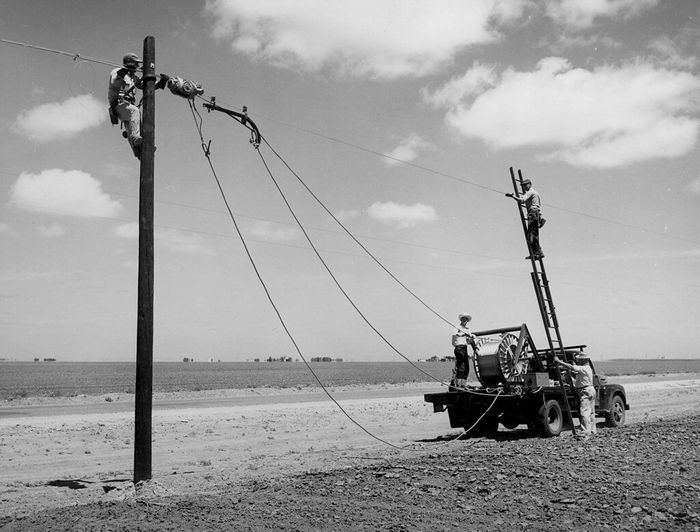For Rural America, Broadband Access Today is what Electricity Access was 100 Years Ago

Broadband access today is what electricity access was 100 years ago. Without it, rural communities like those on Maryland’s Eastern Shore and elsewhere can’t compete. Our young people lose educational opportunities, and our budding entrepreneurs can’t start businesses. Farmers use technology connections to manage and store data, and even operate certain high-tech machinery. And telecommuting is a challenge for us when it shouldn’t be. Anyone who’s tried to learn while sharing a weak home connection with three or four other users, or driven 30 miles or more to a Starbucks parking lot so they could attend a crucial Zoom meeting, knows what I’m talking about.
Efforts to address the connectivity gap have come and gone for more than a decade. In Maryland, a state task force assigned to review this problem issued a report with recommendations in 2019. In response, Gov. Larry Hogan announced a plan to spend $9.6 million to connect about 5,000 households. It’s a great start, but the problem is much bigger. According to the task force’s own report, over 300,000 Marylanders are without high-speed internet. The Federal Communications Commission reported last year that 18 million Americans lack broadband access, and that’s likely a low estimate.
The piecemeal approach tried so far can bring modest gains, but in the end, large, national problems like this demand national solutions. That’s why I applaud recent efforts at the federal level to address this critical need, especially House Majority Whip James Clyburn’s Accessible, Affordable Internet for All Act, a $100 billion initiative to deliver high-speed broadband to underserved areas. Rep. Clyburn formed the House Rural Broadband Task Force in 2019 with the goal of bringing affordable high-speed Internet to 100 percent of Americans. “Since then,” he says, “the disparity between those served and unserved has become even clearer.” Pandemic living has shined a glaring light on the digital divide.
In addition to deploying the physical infrastructure to make near-universal access a reality, the Clyburn bill would also require internet service providers to offer affordable options, provide grants for states to close gaps and help rural students with innovative solutions such as Wi-Fi access on school buses. Given the covid-19 crisis and many competing priorities, the bill has languished since it was introduced last June. Now, with both the Biden administration and Democratic majorities in Congress on record supporting high-speed broadband, this issue needs to move up the list of priorities.
The passage last month of President Biden’s American Rescue Plan presents another opportunity for progress. This sweeping legislation includes $350 billion in aid to state and local governments; Maryland’s share is about $4 billion. Governor Hogan and the General Assembly should dedicate a portion of that funding to meeting the needs identified in the 2019 state task force report. A set-aside of just 2 percent, or $80 million, could put a significant dent in the “last mile” challenge facing the Eastern Shore and elsewhere in rural Maryland.
Some steps have already been taken at the federal level under the Rural Digital Opportunity Fund, a 10-year, multibillion-dollar FCC program. But experts have questioned the FCC’s process for disbursing those funds, and the billions spent previously on similar initiatives relied on untrustworthy service-area mapping. Clearly, we need a more robust federal effort — well coordinated, well researched, and adequately funded.
The good news is, after four years of jokes about “Infrastructure Week,” we finally have leadership in Washington that recognizes how critical it is to create and properly maintain the building blocks of a healthy economy: roads, bridges, mass transit, utility lines, and, yes, high-speed broadband. Infrastructure was once a nonpartisan issue, and there’s no reason it can’t be again. Just as Democrats, Republicans, and independents alike want sturdy bridges and safe highways, everyone needs to be able to get online quickly and reliably.
To be sure, this problem does not affect only rural people. The Abell Foundation recently reported that more than 40 percent of households in Baltimore City lack broadband access. But what Rep. Clyburn and his federal Rural Broadband Taskforce have recognized, is how rural people are especially vulnerable to being bypassed in this regard — just as they were in previous eras.
Electrification brought rural America into the 20th century, and life without it soon became unimaginable. In this Information Age, access to high speed Internet has taken its deserved place among the necessities of contemporary life. Every Marylander — indeed, every American — deserves a chance to compete on the even playing field that only universal high-speed broadband provides. Two decades into this new century, we can no longer wait.
Former state delegate Heather Mizeur, a resident of Chestertown, is a Democratic candidate for Congress in Maryland’s First District.
This commentary was first published in The Baltimore Sun on March 15, 2021.
Common Sense for the Eastern Shore








